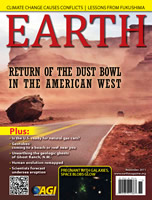 A pair of mineral clues recently found in a fossil seafloor may be signs that ancient bacteria helped create banded iron formations — Precambrian-aged sedimentary rocks known for their vibrant, reddish- brown-colored thin layers — that researchers use to reconstruct ancient interactions between the atmosphere, the ocean and the seafloor.
A pair of mineral clues recently found in a fossil seafloor may be signs that ancient bacteria helped create banded iron formations — Precambrian-aged sedimentary rocks known for their vibrant, reddish- brown-colored thin layers — that researchers use to reconstruct ancient interactions between the atmosphere, the ocean and the seafloor.
For a long time, “there’s been this big controversy about how banded iron formations formed,” says geochemist Simon Poulton of Leeds University in the United Kingdom, who was not involved with the new research. For the most part, researchers assume that many of the elements that they find in banded iron formations got there by hitching a ride through the ocean on iron molecules, he says. Now, a team led by Yi-Liang Li of the University of Hong Kong claims that an unusual combination of minerals found in Western Australia shows that some banded iron formations formed with the help of living microbes.
The team found an iron acetate salt — a compound sometimes formed from the kind of carbon found in living things — in a 2.48-billion-year- old banded iron formation. The researchers also found a mixture of magnetite and apatite, which they say resembles residues left behind by some phosphorus-consuming modern-day bacteria. To understand the ancient mineral mixture’s origin, Li and colleagues grew cultures of modern magnetite-producing bacteria and compared their magnetite to nonbiological magnetite.
The ancient magnetite more closely resembled the biological magnetite, Li and colleagues reported in Geology. Taken together, the two pieces of evidence imply a biological origin for some of the banded iron formations, they wrote.
Yet their interpretation of the magnetite morphology is confusing, says David Johnston, a geobiologist at Harvard University. The team identifies two groupings of magnetites based on their shape and the ratio of two types of iron: one with biological origins and one with nonbiological origins. The researchers claim that the ancient magnetite falls into the group with biological origins. But the other group, the “nonbiological group,” also contains biological magnetites, Johnston says. The study also does not rule out the possibility that phosphorus could hitch a ride to the seafloor free of bacterial help, he says. “The mineralogy they report might be suggestive of bacteria … but I don’t think it precludes the phosphorus getting there inorganically.”
Furthermore, Johnston says, the banded iron formation in which all the evidence rests could have changed since it was deposited: “Once you hit the sedimentary environment, these things get reworked” by temperature and pressure changes and the flow of fluids through the rock.
“What [this study] does is muddy the waters a bit,” Poulton says. “If phosphorus is also [sinking to the seafloor] with organic matter, that makes it even more complicated.” Some of these minerals and some of these banded iron formations may indeed have come from living things, he adds, “just not all of them.”
The history of phosphorus and iron in ancient waters may be complicated, but if researchers can unravel the clues in banded iron formations, they may be able to better estimate ancient oxygen levels in the oceans. “We know today how many oxygen-producing cyanobacteria exist in the oceans and from that we can calculate how much oxygen is being produced,” says Kurt Konhauser of the University of Alberta in Edmonton, a co-author on the study. “At 2.5 billion years ago … cyanobacteria already existed, but just how many and how much oxygen was generated is unknown.” But if such bacteria left behind a signature in banded iron formations, modern-day researchers might use it to estimate ancient oxygen levels, he says.
In addition, finding the iron acetate salt was a surprise, the team says. Because such salts are easy for bacteria to consume, they don’t tend to stick around very long. “For there to still be a very, very biologically available phase is profound,” Johnston says. Indeed, Li says, it “implies that simple organic molecules existed in the 2.48-billion-year-old ocean,” possibly fueling microbial life even in places too deep for solar light to reach.
This news story appeared in the November issue of EARTH Magazine [pdf]
Dear Lucas,
I appreciate your nice comments on our Geology paper in 2011 on the mineralogical evidence of microbial life in the BIF-deposited oceans. I have one more paper will appear on Earth and Planetary Science Letter very soon. In this paper, I reported the observations on microbands in banded iron formations and nanobands in hematite of banded iron formation, which are probably records of annual precipitation because of seasonal change and daily precipitation because of the circadian metabolism by photosynthetic microorganisms. It is interesting that annual and even daily processes of 2.5 billion years ago are so well-preserved in these geological archives.
This paper is open accesssed and the link of it is:
http://authors.elsevier.com/sd/article/S0012821X14000600
Have fun!
YL Li, Assistant Professor of Astrobiology, the University of Hong Kong.